

 |
Search the Site with

|
| Sorry, no coat of arms available. | 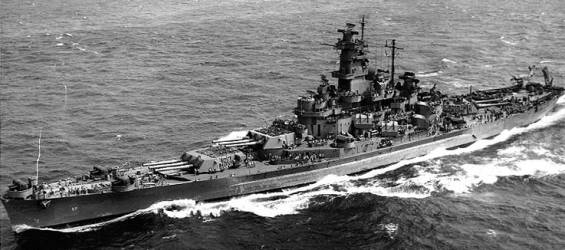 |
USS SOUTH DAKOTA was the lead ship of the SOUTH DAKOTA - class of battleships and the second ship in the Navy named after the state. Decommissioned on January 31, 1947, the SOUTH DAKOTA spent the next years berthed at the Philadelphia Naval Shipyard, until stricken from the Navy list on June 1, 1962. On October 25, 1962, the SOUTH DAKOTA was sold to Lipsett Division, Luria Bros. and Co., Inc., for scrap.
| General Characteristics: | Keel laid: July 5, 1939 |
| Launched: June 7, 1941 | |
| Commissioned: March 20, 1942 | |
| Decommissioned: January 31, 1947 | |
| Builder: New York, Shipbuilding, Camden, NJ | |
| Propulsion system: boilers, four Westinghouse geared turbines | |
| Propellers: four | |
| Length: 680.8 feet (207.5 meters) | |
| Beam: 108 feet (32.9 meters) | |
| Draft: 36 feet (11 meters) | |
| Displacement: Light: approx. 38,000 tons | |
| Full: approx. 44,374 tons | |
| Speed: 28 knots | |
| Aircraft: three planes | |
| Catapults: two | |
| Crew: 2354 (War), 1793 (Peace) | |
| Last armament: Nine 16-inch / 45 caliber guns; sixteen 5-inch / 38 caliber guns; sixty-eight 40 mm guns and seventy-six 20 mm guns |
Crew List:
This section contains the names of sailors who served aboard USS SOUTH DAKOTA. It is no official listing but contains the names of sailors who submitted their information.
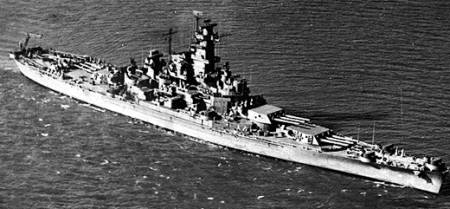
History of USS SOUTH DAKOTA:
USS SOUTH DAKOTA was laid down on 5 July 1939 at Camden, NJ, by the New York Shipbuilding Corp.; launched on 7 June 1941; sponsored by Mrs. Harlan J. Bushfield; and commissioned on 20 March 1942, Capt. Thomas L. Gatch in command.
After fitting out at Philadelphia, SOUTH DAKOTA held shakedown training from 3 June to 26 July 1942. She stood out of Philadelphia Navy Yard on 16 August and headed for Panama. The battleship transited the Panama Canal on 21 August and set course for the Tonga Islands, arriving at Nukualofa, Tongatabu, on 4 September. Two days later, she struck an uncharted coral pinnacle in Lahai Passage and suffered extensive damage to her hull. On 12 September, the ship sailed for the Pearl Harbor Navy Yard and repairs.
SOUTH DAKOTA was ready for sea again on 12 October 1942 and began training with Task Force (TF) 16 which was built around aircraft carrier USS ENTERPRISE (CV 6). The task force sortied from Pearl Harbor on 16 October to join TF 17, which was centered on carrier USS HORNET (CV 8), northeast of Espiritu Santo. The rendezvous was made on the 24th; and the combined force, now operating as TF 61 under Rear Admiral T. C. Kinkaid, was ordered to make a sweep of the Santa Cruz Islands and then move southwest to block any Japanese forces approaching Guadalcanal.
Catalina patrol bombers sighted a Japanese carrier force at noon on October 25, 1942, and TF 61 steamed northwest to intercept it. Early the next morning, when all carrier forces were within striking range, a Japanese snooper spotted the American force, triggering the Battle of Santa Cruz. SOUTH DAKOTA and the ENTERPRISE group were approximately 10 miles from the HORNET group when the air battle began.
The first enemy attack was concentrated against HORNET. At 1045, SOUTH DAKOTA was operating near ENTERPRISE to provide protective fire from her numerous antiaircraft guns when their group was attacked by dive bombers. Approximately an hour later, about 40 torpedo planes struck at the two ships. A third aerial assault, made by dive bombers and torpedo planes, came in at 1230. SOUTH DAKOTA sustained a 500-pound bomb hit on top of her number one turret. When the action was broken off that evening, the American forces retired toward Noumea, New Caledonia, with the battleship credited with downing 26 enemy planes.
At 0414 on 30 October, while avoiding a submarine contact, SOUTH DAKOTA and USS MAHAN (DD 364) collided, causing damage to both ships. MAHAN's bow was turned to port and crumpled to frame 14, and a fire, soon brought under control, started in her forward hold. Both ships continued to Noumea where USS VESTAL (AR 4) repaired SOUTH DAKOTA's collision and battle damage.
On 11 November 1942, SOUTH DAKOTA, as part of TF 16, sortied from Noumea for Guadalcanal. On 13 November, she joined battleship USS WASHINGTON (BB 56) and destroyers USS PRESTON (DD 379), USS WALKE (DD 418), USS BENHAM (DD 397), and USS GWIN (DD 433) to form TF 64 under command of Rear Admiral W. A. Lee. The next evening at 2330, the force was operating 50 miles southwest of Guadalcanal when Lee learned that an enemy convoy was coming through the passage off Savo sometime between 0030 and 0230. This was Admiral Kondo's bombardment group consisting of the battleship KIRISHIMA; heavy cruisers TAKAO and ATAGO; and a destroyer screen.
Admiral Kondo's forces were divided into three sections: the bombardment group; a close screen of cruiser NAGARA and six destroyers; and a distant screen of cruiser SENDAI and three destroyers in the van of the other forces. A quarter moon assured good visibility. Three ships were visually sighted from the bridge of SOUTH DAKOTA, range 18,100 yards. WASHINGTON fired on the leading ship, thought to be a battleship or heavy cruiser; and, a minute later, SOUTH DAKOTA's main battery opened on the ship nearest to her. Both initial salvos started fires on the targets. SOUTH DAKOTA then fired on another target and continued firing until it disappeared from her radar screen. Turret No. 3 - firing over her stern and demolishing her own planes in the process - opened on another target and continued firing until the target was thought to sink. Her secondary batteries were firing at eight destroyers close to the shore of Savo Island.
A short lull followed after which radar plot showed four enemy ships, just clear of the left tangent of Savo, approaching from the starboard bow; range 5,800 yards. Searchlights from the second ship in the enemy column illuminated SOUTH DAKOTA. WASHINGTON opened with her main battery on the leading, and largest, Japanese ship. SOUTH DAKOTA's secondary batteries put out the lights; and she shifted all batteries to bear on the third ship, believed to be a cruiser, which soon gushed smoke. SOUTH DAKOTA, which had been under fire from at least three of the ships, had taken 42 hits which caused considerable damage. Her radio communications failed; radar plot was demolished; three fire control radars were damaged; there was a fire in her foremast; and she had lost track of WASHINGTON. As she was no longer receiving enemy fire and there were no remaining targets, she withdrew; met WASHINGTON at a prearranged rendezvous; and proceeded to Noumea. Of the American destroyers, only GWIN returned to port. The other three had been severely damaged early in the engagement. WALKE and PRESTON were sunk. BENHAM had part of her bow blown off by a torpedo and, while en route to Noumea with the damaged GWIN as her escort, had to be abandoned. GWIN then sank her by gunfire. On the enemy side, hits had been scored on TAKAO and ATAGO; KIRISHIMA and destroyer AYANAMI, severely damaged by gunfire, were abandoned and scuttled.
USS PROMETHEUS (AR 3) repaired some of the damage inflicted on SOUTH DAKOTA at Noumea, enabling the battleship to sail on the 25th for Tongatabu and thence for home. SOUTH DAKOTA arrived at New York on 18 December 1942 for an overhaul and the completion of repairs to her battle damage. She was back at sea on 25 February 1943 and, following sea trials, operated with USS RANGER (CV 4) in the North Atlantic until mid-April.
The battleship next operated with the British Home Fleet, based at Scapa Flow, until 1 August when she returned to Norfolk. On 21 August, SOUTH DAKOTA stood out of Norfolk en route to Efate Island, arriving at Havannah Harbor on 14 September. She moved to Fiji on 7 November and sortied from there four days later with Battleship Divisions (BatDiv) 8 and 9 in support of Task Group (TG) 50.1, the Carrier Interceptor Group for Operation Galvanic, the Gilbert Islands assault. The carriers launched attacks against Jaluit and Mili atolls, Marshall Islands, on 19 November 1943, to neutralize enemy airfields there. The force then provided air support for the amphibious landings on Makin and Tarawa, Gilbert Islands.
SOUTH DAKOTA, with five other battleships, formed another task group on 6 December to bombard Nauru Island. A joint aerial attack and shore bombardment severely damaged enemy shore installations and airfields there. SOUTH DAKOTA retired to Efate on 12 December 1943 for upkeep and rearming.
Her next action occurred on 29 January 1944 when the carriers launched attacks against Roi and Namur, Marshall Islands. The next day, the battleship, along with sister ship USS ALABAMA (BB 60), and the fast battleship USS NORTH CAROLINA (BB 55), moved in to shell enemy positions on Roi and Namur. SOUTH DAKOTA then rejoined the carriers as they provided air support for the amphibious landings on Kwajalein, Majuro, Roi, and Namur.
SOUTH DAKOTA departed the Marshall Islands on 12 February with the Truk striking force which launched attacks against that Japanese stronghold on 17 and 18 February 1944. Six days later, she was in the screen for the carriers that launched the first air attacks against the Marianas. The force was under constant enemy air attack, and SOUTH DAKOTA splashed four Japanese planes. She returned to Majuro from 26 February until 22 March when she sailed with the fast carrier forces of the 5th Fleet. Air strikes were delivered from 30 March until 1 April against Palau, Yap, Woleai, and Ulithi in the Western Caroline Islands.
SOUTH DAKOTA returned to Majuro on 6 April 1944 and sailed the following week, again accompanying the fast carriers. On 21 April, strikes were launched against Hollandia, New Guinea, and the following day against Aitape, Tanahmerah, and Humboldt Bays to support the Army landings. On 29 and 30 April, the carriers, with SOUTH DAKOTA still in the screen, returned to Truk and bombed that base. The next day, the battleship was part of a surface bombardment group that shelled Ponape Island in the Carolines. She returned to Majuro for upkeep from 4 May to 5 June when she got underway with TF 58 to participate in Operation Forager, the landings on Saipan and Tinian. The carriers began launching attacks on the 11th against enemy installations throughout the islands. On the 13th, SOUTH DAKOTA and six other battleships were detached from the fast carrier groups to bombard Saipan and Tinian. SOUTH DAKOTA shelled the northwest coast of Tanapag Harbor, Saipan, for over six hours with both her primary and secondary batteries.
On the evening of May 15, 1944, 8 to 12 enemy fighters and bombers broke through the combat air patrol and attacked the task group. SOUTH DAKOTA fired at four and splashed one; and the remaining 11 were shot down by fire from other ships. On 19 June, the battleship was again operating with the fast carriers. It was known that a major Japanese force was approaching from the west, and the American capital ships were placed so that they could continue to support the ground forces on Saipan and also intercept this enemy force.
At 1012, a large group of bogies was reported coming in from the west. At 1049, a "Judy" dropped a 500-pound bomb on SOUTH DAKOTA's main deck where it blew a large hole, cut wiring and piping, but inflicted no other serious material damage. However, personnel losses were heavy: 24 killed and 27 wounded. The ship continued to fight throughout the day, as air attacks were continuous. This was the first day of the Battle of the Philippine Sea and was called the "Marianas Turkey Shoot" as the Japanese lost over 300 aircraft. The air battle continued throughout the 20th. When it ended, the badly mauled Japanese fleet no longer posed a threat to the American conquest of the Marianas. The task group returned to Ulithi on 27 June, and SOUTH DAKOTA sailed via Pearl Harbor to the west coast, arriving at Puget Sound on 10 July 1944.
The battleship was overhauled at the navy yard there; and, after sea trials, sailed on 26 August for Pearl Harbor. SOUTH DAKOTA was routed to Ulithi and, upon her arrival, was attached to TG 38.3; one of four task groups of formed Task Force 38, the Fast Carrier Task Force. The task force sortied on 6 October and, four days later, launched air attacks against Okinawa. On the 12th and 13th, attacks were flown against shipping and installations in Formosa. Three of the groups, including SOUTH DAKOTA's, retired and operated east of the Philippine Islands until 24 December. During the operation, carriers of the group flew strikes against targets on Manila and Luzon to support the landings on Mindoro. From 30 December 1944 through 26 January 1945, the fast carriers alternated strikes between Formosa on 3, 4, 9, 15, and 21 January; Luzon on the 6th and 7th; Cape San Jacques and Camranh Bay on the 12th; Hong Kong and Hainan on the 16th; and against Okinawa on 22 January.
SOUTH DAKOTA operated with the fast carriers in their strikes against the Tokyo area on 17 February 1945 and against Iwo Jima on the 19th and 20th in support of amphibious landings there. Tokyo again was the target on the 25th, and Okinawa's turn came on 1 March. After rearming at Ulithi, the task groups sailed toward Japan again and pounded targets in the Kobe, Kure, and Kyushu areas on 18 and 19 March. They launched strikes against Okinawa on the 23rd; and, on the 24th, the battleship joined a bombardment group which shelled southeastern Okinawa. She rejoined her task group which, after bombing Okinawa, struck enemy airfields in southern Kyushu on the 29th and then, from 31 March through 3 April, again pounded targets on Okinawa. On 7 April 1945, all fast carriers launched attacks against an enemy fleet off southwest Kyushu, sinking Japan's fast super battleship YAMATO, two cruisers, and four destroyers.
SOUTH DAKOTA once more participated in shore bombardment on southeastern Okinawa on 19 April in support of an all-out offensive by the XXIV Army Corps against enemy lines.
While re-arming from USS WRANGELL (AE 12) on 6 May, a tank of 16-inch high capacity powder exploded, causing a fire and exploding four more tanks. Turret No. 2 magazines were flooded and the fires put out. The ship lost three men killed instantly; eight more died of injuries; and 24 others suffered non-fatal wounds. The ship retired to Guam from 11 to 29 May when she sailed for Leyte, arriving on 1 June.
SOUTH DAKOTA departed Leyte on 1 July, supporting the carriers of TG 38.1 which attacked the Tokyo area on the 10th. On 14 July, as part of a bombardment group, she participated in the shelling of the Kamaishi Steel Works, Kamaishi, Honshu, Japan. This was the first gunfire attack on the Japanese home islands by heavy warships. From 15 through 28 March, SOUTH DAKOTA again supported the carriers as they launched strikes against Honshu and Hokkaido. On the night of 29 and 30 July, she participated in the shore bombardment of Hamamatsu, Honshu, and, on the 9th, again shelled Kamaishi. The battleship supported the carriers in strikes against northern Honshu on 10 August 1945, and in the Tokyo area on the 13th and 15th. The latter was the last strike of the war for, later that day, Japan capitulated.
She anchored in Sagami Wan, Honshu, on 27 August and entered Tokyo Bay on the 29th. SOUTH DAKOTA steamed out of Tokyo Bay on 20 September and proceeded, via Okinawa and Pearl Harbor, to the west coast of the United States. On 29 October, she moved down the coast from San Francisco to San Pedro. She sailed from the west coast on 3 January 1946 for Philadelphia and a yard overhaul. In June, she was attached to the Atlantic Reserve Fleet.
On 31 January 1947, she was placed in reserve, out of commission. The battleship remained in that status until she was struck from the Navy list on 1 June 1962. On 25 October 1962, she was sold to Lipsett Division, Luria Bros. and Co., Inc., for scrap.
SOUTH DAKOTA received 13 battle stars for World War II service.
USS SOUTH DAKOTA Image Gallery:
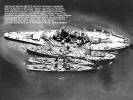 | 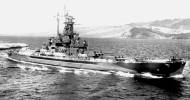 | 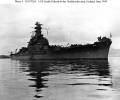 | 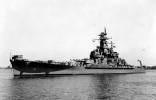 | 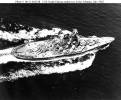 |
 Back to Battleships list.
Back to Battleships list.  Back to ships list.
Back to ships list.  Back to selection page.
Back to selection page.  Back to 1st page.
Back to 1st page.